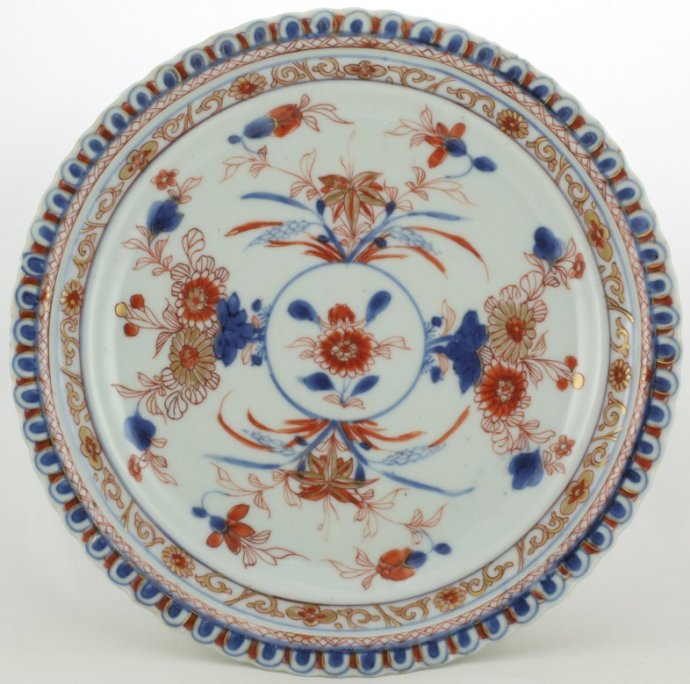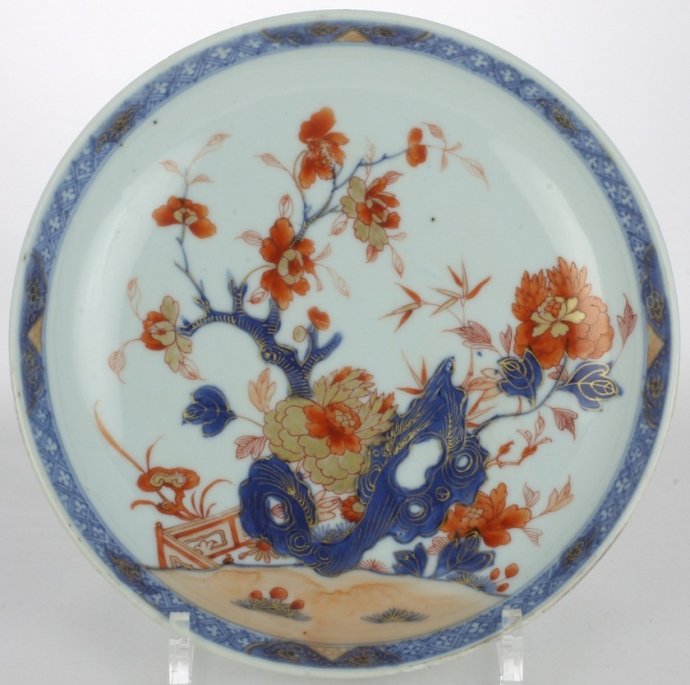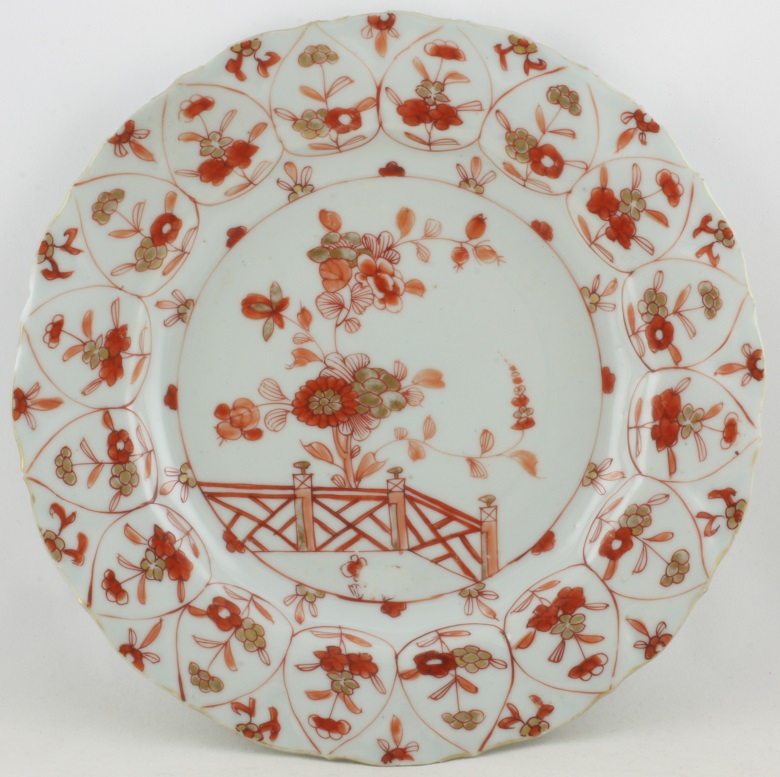Chinese Porcelain
Chinese Imari 1700-1800
Page 1
Chinese porcelain producers developed new types of decorations in the early 18th century, Chinese Imari being one of them. It is characterised by a combination of underglaze blue and overglaze red and gold. Details are sometimes in black and green enamels. This development was a reaction to the success of Japanese Imari porcelain with a similar colour scheme. Sometimes Chinese imitations are direct copies of Japanese examples but more often Chinese Imari is decorated with typical Chinese motifs that are closely related to the underglaze-blue patterns of the period. However, the use of red and gold makes Chinese Imari more lavish. Landscapes, flowering plants, birds and mythical creatures are recurring motifs. Depictions of humans are less frequent and apart from armorial pieces, European designs are quite rare. The shapes fit into the normal export assortment. Chinese Imari was not only in demand in the West, but also in south-east Asia, India, and the Ottoman Empire. In the VOC (Dutch East India Company, 1602–1799) records it is called 'Chinese-Japanese' and in addition to blue and white and enamelled wares, this was a standard type in the Company's assortment that was bought in Canton until the end of the 18th century.

Chinese Imari 1700-1800 - Page 1
Object 2012583
Teapot
China
1700-1720
Height with cover 125 mm (4.92 inch), height without cover 87 mm (3.43 inch), diameter handle to spout 151 mm (5.94 inch), dimension of mouthrim 50 mm (1.97 inch), diameter of footring 52 mm (2.05 inch), weight with cover 324 grams (11.43 ounce (oz.)), weight cover 44 grams (1.55 ounce (oz.))
Pear-shaped, ribbed teapot with fluted body on footring. Straight spout, curved C-shaped handle. Domed ribbed cover with a ribbed round knob. Chinese Imari, decorated in underglaze blue, overglaze iron-red and gold with flower sprays and various butterflies in flight. On the spout and handle flower sprays. The cover is decorated en suite.
Condition: Firing flaws to mouthrim and the underside of rim of the cover, a firing tension hairline (caused by the firing process) to the top attachment of the handle to the body and two very tiny fleabites to the tip of the spout.
Price: € 499 Currency Converter

Chinese Imari 1700-1800 - Page 1
Object 2011668
Dish
China
1720-1730
Height 28 mm (1.10 inch), diameter of rim 222 mm (8.74 inch), diameter of footring 116 mm (4.57 inch), weight 320 grams (11.29 ounce (oz.))
Dish on footring, flat underglaze brown-edged rim (jia mangkou). Chinese Imari, decorated in underglaze blue, overglaze iron-red, green and black enamel and gold with a half-open scroll showing a bamboo tree and a magpie perched on the branch of a prunus tree. The scroll is outlined by rather pronounced Japanese foliate and floral scrolls with chrysanthemum flowerheads. On the reverse three flowering sprays.
Chinese Imari was first introduced in the early years of the 18th century as an imitation of Japanese 'Imari'. It was based on a simpler form and was essentially an export type. The Chinese did not imitate the Japanese Imari models but copied the designs like kiku (chrysanthemum), roundels and half-roundels, fan-shaped panels, partly unrolled bamboo blinds and rather pronounced foliate and floral scrolls. The Japanese Imari colour combination was also copied, the Chinese Imari colour palette consisted of iron-red enamel and gold in combination with underglaze blue. Sometimes other colours, and even certain enamels of the famille verte such as green and black, were sparingly introduced and used in a subtle way. Chinese Imari remained popular into the 1720 after which it became overshadowed by opaque enamels. (Howard & Ayers 1978, vol. 1, p.137), (Jörg & Van Campen 1997, p.199), (Sargent 2012, pp.183-188)
On this Chinese Imari dish the half-open scroll and the pronounced foliate and floral scrolls are clearly Japanese design elements copied by the Chinese who in this way tried to appeal to their newly re-established European market. Similar dishes were collected by August the Strong, elector of Saxony and King of Poland, and were also copied by the Meissen porcelain factory around 1760. (Sargent 2012, p.188)
All known published versions of this design show one magpie perched on the branch of a prunus with bamboo. For a version decorated with two phoenixes and chrysanthemum, please see:
For identically decorated dishes, please see:
- China for the West. Chinese Porcelain and other Decorative Arts for Export illustrated from the Mottahedeh Collection, (D.S. Howard & J. Ayers, Philip Wilson Publishers for Sotheby Parke Bernet Publications, London 1978), vol. 1, p.139, cat. 118.
- Early Japanese Porcelain: Arita Porcelain in the Dresden Collection, (F. Reichel, Londen 1981), p.133, cat. 89.
- Important Chinese Export Porcelain from the Mottahedeh Collection, (Sotheby's, New York, Wednesday, January 30, 1985), lot 70.
- Chinese Export Porcelain in the Reeves Center Collection at Washington and Lee University, (Th. V. Litzenburg, London 2003), p.78, cat. 62.
- Treasures of Chinese Export Ceramics from the Peabody Essex Museum, (W.R. Sargent, Salem, Massachusetts, 2012), p.188, plate 87.
- Royal Collection Trust - Works of Art - RCIN 6435
Condition: A frit, a chip and a hairline to the rim.
References:
Howard & Ayers 1978, vol. 1, cat. 118
Price: € 299 Currency Converter

Chinese Imari 1700-1800 - Page 1
Object 2011685
Bowl
China
1715-1725
Height 75 mm (2.95 inch), diameter of rim 154 mm (6.06 inch), diameter of footring 65 mm (2.36 inch), weight 282 grams (9.95 ounce (oz.))
Bowl on footring, straight sides and an underglaze brown-edged rim (jia mangkou). Chinese Imari, decorated in underglaze blue, overglaze iron-red and gold with fish alternating with flowering peony sprays above a foaming waves pattern border. Round the rim a trellis pattern border. On the bottom a single fish.
Condition: A firing flaw and a hairline to the rim.
Reference:
Price: € 399 Currency Converter

Chinese Imari 1700-1800 - Page 1
Object 2012350
Dish
China
1720-1735
Height 26 mm (1.02 inch), diameter 211 mm (8.30 inch), diameter of footring 108 mm (4.25 inch), weight 267 grams (9.42 ounce (oz.))
Dish on footring, moulded, egg-shaped, panels in low relief on the rim. Chinese Imari, decorated in underglaze blue, overglaze iron-red and gold with various flowers and a flowering chrysanthemum tree growing from behind a fence. On the sides sixteen panels, each separated by a flower and filled with a flowering chrysanthemum. On the reverse two flower sprays.
The shape, size and design on these Chinese Imari decorated dishes have derived from earlier (Kangxi) examples decorated in 'Red & Gold' / 'Rouge-de-fer' with iron-red, black enamel and gold on the glaze.
Sold object 2012213, an identically, in red and gold / rouge de fer, decorated dish, (this dish is not included in this sale/offer).
Condition: Fleabites to the rim and footring and a chip to the reverse rim.
Price: € 199 Currency Converter

Chinese Imari 1700-1800 - Page 1
Object 2011735
Dish
China
1700-1720
Height 27 mm (1.06 inch), diameter of rim 221 mm (8.70 inch), diameter of footring 129 mm (5.08 inch), weight 351 grams (12.38 ounce (oz.))
Dish on footring, the moulded rim with a scalloped edge. Chinese Imari, decorated in underglaze blue, iron-red and gold. In the centre a medallion with a flower spray. The medallion is surrounded by four groups of flowering plants and encircled by a double border, one with floral scrolls and flowerheads. the other with a crossed lines pattern. Each of the small modelled lobes of the rim has a stylised lotus-petal motif. On the reverse two flower sprays.
The scalloped rim and edge with its many tiny indented panels is modelled after an European metal or ceramic dish. (Jörg & Van Campen 1997, p.101), (Jörg 2011/2, p.42)
An identical bowl and dish, probably used in Europe for serving soup. are in the Wallenstein collection. (Suchomel 2015, p.377)
For this indentically shaped and decorated bowl and dish please see:
For a dish decorated with famille verte enamels and with a similarly scalloped rim and edge, please see:
Condition: Firing flaws to the base and reverse rim, glaze rough spots to the edge and footring and a shallow chip to the reverse rim.
References:
Jörg & Van Campen 1997, cat. 91
Price: € 249 Currency Converter

Chinese Imari 1700-1800 - Page 1
Object 2010545
Dish
China
1725-1740
Height 40 mm (1.57 inch), diameter of rim 208 mm (8.19 inch), diameter of footring 130 mm (5.12 inch), weight 415 grams (14.64 ounce (oz.))
Dish on footring, straight rim. Chinese Imari, decorated in underglaze blue, overglaze iron-red and gold with a flowering peony and bamboo tree growing from pierced rockwork near a fence. On the rim a diaper pattern border with eight reserves four filled with a single flower and four with a double flower. The reverse is undecorated.
Condition: A chip, three fleabites and some rough spots to the rim.
Price: € 249 Currency Converter



 create websites
create websites